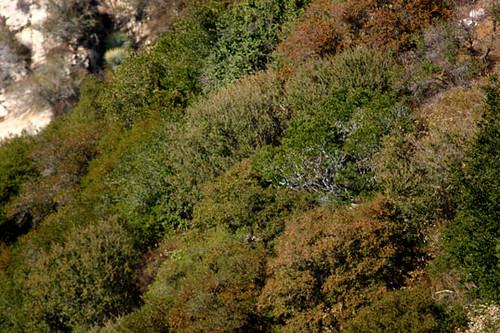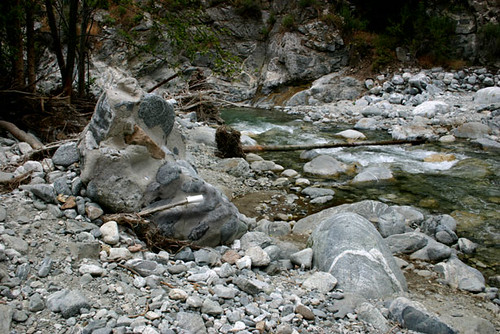The variety of genetic material within a single species, variety within a community, and variety within an ecosystem is healthy and stable. The differences offer the individuals and the community plasticity to weather disease, environmental alterations and many disasters. If you take a snap shot of a healthy and rarely disturbed system, the heterogeneity is apparent - although, in a wetland the distinctive differences exist in the animals and not the plants. This snap shot was taken of the San Gabriel Mountains on a steep slope where people rarely, if ever venture.
Saturday, June 25, 2005
all-the-same
The advantages of individualism are understood - and so is the herd mentality. Protection of vital resources is understood but so are the consequences of degradation.
Saturday, June 11, 2005
toilet
When ever people go into the National Forests, the damage they do to the area is related to their access, their numbers and the length of time they can stay. The closer the public is to a National Forest, the more likely it will be filled with trash and painted with spray paint. The best thing for Nature is to restrict the public's use. The great forests can recover, but only if the people stay away for extended periods of time.
If more of the public were knowledgeable about what they should and should not do in the Forest, less harm would be done and more people could enjoy the resource and more of the plants and animals would healthier. If people translated that understanding to their own habitat, more people would be healthier.
mite-on-Frosti
This Cicindela frosti from Mugu Lagoon in Southern California, has a mite attached to its elytra (the arrow points to the shiny spot). Tiger and other beetles are targeted by mites because they are very mobile larger animals and can transport the mites to new areas.
The mites are usually in the hypopus stage where the mite's life cycle is truncated and its organs have altered. Hypopi do not have mouth parts and usually have incomplete guts. However, when the larger animal is weakened by lack of water, food, or is advanced in age or hurt in some way, the mite transforms into a eating, growing and reproducing machine.
In some ways, the mite not only hitches a ride to new places but may actually be waiting for its important meal to die. The question remains, do the attachments of the mites cause the host to loose vitality and to succumb more quickly?
Sunday, June 05, 2005
Yucca forest

I love these majestic yuccas. I love the moths that pollinate them - they cannot be pollinated without the yucca moths (go here for a wonderful story - http://waynesword.palomar.edu/ww0902a.htm ). How two separate organisms from separate Kingdoms have intertwined their existence is beautiful. One cannot exist for long without each other or without intervention by another organism... like people. But people are fickle. They tire and get bored. Like the story of the Emperor and the Nightingale, they look for sparkly mechanical things to entertain them....



